View in other NatureServe Network Field Guides
NatureServe
Montana
Utah
Wyoming
Idaho
Wisconsin
British Columbia
South Carolina
Yukon
California
New York
Arctic Blue - Agriades glandon
Native Species
Global Rank:
G5
State Rank:
S5
Agency Status
USFWS:
USFS:
BLM:
External Links
General Description
[From Ferris and Brown 1981; Scott 1986; Opler and Wright 1999; Glassberg 2001; Pyle 2002] Forewing 1.2-1.4 cm. Forewings pointed, forewings and hindwings with prominent dark dorsal cell bars. Uppersurface of male blueish-gray, female orange-brown. Both sexes with dark cell spots on both wings. Undersurface of hindwing with postmedian black spots lacking or enclosed by broad white postmedian band or series of spots in darker background.
Phenology
One flight; July and August in most of range, mid-June to mid-July at low altitude, June to mid-July in Alberta and Saskatchewan, late June and July in the Arctic (Scott 1986). June to August and September (Glassberg 2001), mostly July and August in Washington (Pyle 2002), late May to late August, depending on elevation, in British Columbia (Guppy and Shepard 2001).
Diagnostic Characteristics
Best determined by a combination of the uppersurface of male blueish-gray, undersurface of hindwing in both sexes with postmedian black spots lacking or enclosed by broad white postmedian band or series of spots in darker background.
Species Range
Montana Range
Range Descriptions
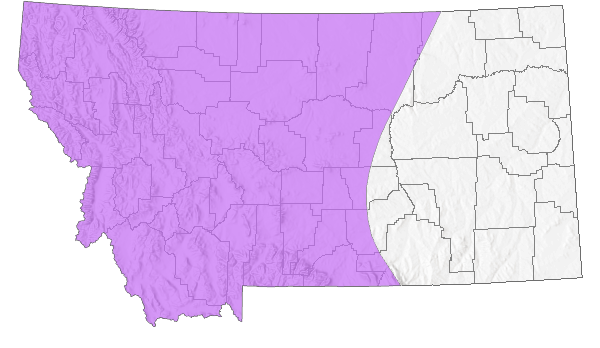
 Native
Native
Range Comments
Holarctic. In North America, from Alaska east to Newfoundland and Greenland, south through the western mountains to Washington in the Cascades, northern Arizona and New Mexico in the Rocky Mountains (Scott 1986; Opler and Wright 1999; Glassberg 2001); mostly above 1829 m to at least 4145 m elevation in Colorado (Scott and Scott 1978, Ferris and Brown 1981), 1524 m to at least 2438 m elevation in Washington (Pyle 2002), 500 m to 2000 m elevation in British Columbia (Guppy and Shepard 2001). In Montana, reported from the western 2/3 of the state (Kohler 1980; Stanford and Opler 1993). Mainly uncommon to common, but common to abundant in California Sierra Nevada (Glassberg 2001).
Observations in Montana Natural Heritage Program Database
Number of Observations: 8
(Click on the following maps and charts to see full sized version)
Map Help and Descriptions
Relative Density
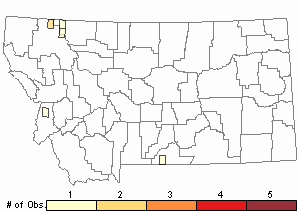
Recency
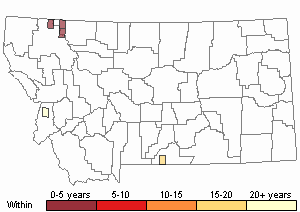
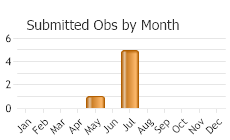
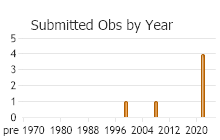
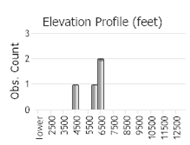 (Observations spanning multiple months or years are excluded from time charts)
(Observations spanning multiple months or years are excluded from time charts)
Migration
Non-migratory.
Habitat
Mountain meadows, montane wet meadows, prairie, low ridges, slopes, trails, above treeline in alpine terrain (Garth and Tilden 1963; Emmel 1964; Scott 1986, Opler and Wright 1999; Glassberg 2001; Pyle 2002). In Glacier National Park, Montana reported from subalpine areas and above treeline in alpine terrain (Debinski 1993).
Food Habits
Larval food plants include Androsace, Astragalus, Diapensia, Dodecatheon, Douglasia, and Saxifraga (Emmel et al. 1970; Scott 1986, 1992, 2006; Guppy and Shepard 2001; Pyle 2002; James and Nunnallee 2011). Adults feed on flower nectar (including Achillea, Agoseris, Antennaria, Arnica, Astragalus, Barberea, Cerastium, Chrysanthemum, Erigeron, Eriogonum, Fragaria, Geranium, Geum, Haplopappus, Heterotheca, Hymenoxys, Machaeranthera, Melilotus, Oxalis, Oxytropis, Penstemon, Polygonum, Potentilla, Prunus, Rudbeckia, Saxifraga, Sedum, Senecio, Solidago, Symphyotrichum, Taraxacum, Tetradymia, Tragopogon) and mud (Scott 2014).
Reproductive Characteristics
Females lay eggs singly (up to 25) under host plant leaf, less often on top of leaf or in flower (Emmel et al. 1970; Scott 1986, 1992, 2006; James and Nunnallee 2011). Number of eggs per oviarole (1/8 of total) about 100 (Ehrlich and Ehrlich 1978). Eggs hatch in about 6-12 days (depending on temperature), larvae do not build nest, develop from egg-hatch to L4 instar and pupation in captivity in about 39 days, adults eclose (emerge from pupa) in 14 days. Larvae overwinter as L1-L3 instars, also as pupae (Scott 1979; Guppy and Shepard 2001; James and Nunnallee 2011). Males patrol throughout the day near host plants (Scott 1975) or perch on rocks (James and Nunnallee 2011) in search of females.
Stewardship Responsibility
References
- Literature Cited AboveLegend:
 View Online Publication
View Online Publication Debinski, D. 1993. Butterflies of Glacier National Park, Montana. Occasional Papers of the Museum of Natural History, the University of Kansas, Lawrence, Kansas. No. 159: 1-13.
Debinski, D. 1993. Butterflies of Glacier National Park, Montana. Occasional Papers of the Museum of Natural History, the University of Kansas, Lawrence, Kansas. No. 159: 1-13. Ehrlich, A.H. and P.R. Ehrlich. 1978. Reproductive strategies in the butterflies: I. Mating frequency, plugging, and egg number. Journal of the Kansas Entomological Society 51(4): 666-697.
Ehrlich, A.H. and P.R. Ehrlich. 1978. Reproductive strategies in the butterflies: I. Mating frequency, plugging, and egg number. Journal of the Kansas Entomological Society 51(4): 666-697. Emmel, J.F., O. Shields, and D.E. Breedlove. 1970. Larval foodplant records for North American Rhopalocera Part 2. Journal of Research on the Lepidoptera 9(4): 233-242.
Emmel, J.F., O. Shields, and D.E. Breedlove. 1970. Larval foodplant records for North American Rhopalocera Part 2. Journal of Research on the Lepidoptera 9(4): 233-242. Emmel, T.C. 1964. The ecology and distribution of butterflies in a montane community near Florissant, Colorado. American Midland Naturalist 72(2): 358-373.
Emmel, T.C. 1964. The ecology and distribution of butterflies in a montane community near Florissant, Colorado. American Midland Naturalist 72(2): 358-373. Ferris, C.D. and F.M. Brown (eds). 1981. Butterflies of the Rocky Mountains. Univ. of Oklahoma Press. Norman. 442 pp.
Ferris, C.D. and F.M. Brown (eds). 1981. Butterflies of the Rocky Mountains. Univ. of Oklahoma Press. Norman. 442 pp. Garth, J.S. and J.W. Tilden. 1963. Yosemite butterflies: an ecological survey of the butterflies of the Yosemite sector of the Sierra Nevada, California. Journal of Research on the Lepidoptera 2: 1-96.
Garth, J.S. and J.W. Tilden. 1963. Yosemite butterflies: an ecological survey of the butterflies of the Yosemite sector of the Sierra Nevada, California. Journal of Research on the Lepidoptera 2: 1-96. Glassberg, J. 2001. Butterflies through Binoculars: A Field Guide to the Butterflies of Western North America. Oxford University Press.
Glassberg, J. 2001. Butterflies through Binoculars: A Field Guide to the Butterflies of Western North America. Oxford University Press. Guppy, C.S. and J.H. Shepard. 2001. Butterflies of British Columbia: including western Alberta, southern Yukon, the Alaska Panhandle, Washington, northern Oregon, northern Idaho, northwestern Montana. UBC Press (Vancouver, BC) and Royal British Columbia Museum (Victoria, BC). 414 pp.
Guppy, C.S. and J.H. Shepard. 2001. Butterflies of British Columbia: including western Alberta, southern Yukon, the Alaska Panhandle, Washington, northern Oregon, northern Idaho, northwestern Montana. UBC Press (Vancouver, BC) and Royal British Columbia Museum (Victoria, BC). 414 pp. James, D.G. and D. Nunnallee. 2011. Life histories of Cascadia butterflies. Corvallis, OR: Oregon State University Press. 447 p.
James, D.G. and D. Nunnallee. 2011. Life histories of Cascadia butterflies. Corvallis, OR: Oregon State University Press. 447 p. Kohler, S. 1980. Checklist of Montana Butterflies (Rhopalocera). Journal of the Lepidopterists' Society 34(1): 1-19.
Kohler, S. 1980. Checklist of Montana Butterflies (Rhopalocera). Journal of the Lepidopterists' Society 34(1): 1-19. Opler, P.A. and A.B. Wright. 1999. A field guide to western butterflies. Second edition. Peterson Field Guides. Houghton Mifflin Company, Boston, Massachusetts. 540 pp.
Opler, P.A. and A.B. Wright. 1999. A field guide to western butterflies. Second edition. Peterson Field Guides. Houghton Mifflin Company, Boston, Massachusetts. 540 pp. Pyle, R.M. 2002. The butterflies of Cascadia: a field guide to all the species of Washington, Oregon, and surrounding territories. Seattle Audubon Society, Seattle, Washington. 420 pp.
Pyle, R.M. 2002. The butterflies of Cascadia: a field guide to all the species of Washington, Oregon, and surrounding territories. Seattle Audubon Society, Seattle, Washington. 420 pp. Scott, J.A. 1975b. Mate-locating behavior of western North American butterflies. Journal of Research on the Lepidoptera 14:1-40.
Scott, J.A. 1975b. Mate-locating behavior of western North American butterflies. Journal of Research on the Lepidoptera 14:1-40. Scott, J.A. 1979. Hibernal diapause of North American Papilionoidea and Hesperioidea. Journal of Research on the Lepidoptera 18(3): 171-200.
Scott, J.A. 1979. Hibernal diapause of North American Papilionoidea and Hesperioidea. Journal of Research on the Lepidoptera 18(3): 171-200. Scott, J.A. 1986. The butterflies of North America: a natural history and field guide. Stanford University Press, Stanford, California.
Scott, J.A. 1986. The butterflies of North America: a natural history and field guide. Stanford University Press, Stanford, California. Scott, J.A. 1992. Hostplant records for butterflies and skippers (mostly from Colorado) 1959-1992, with new life histories and notes on oviposition, immatures, and ecology. Papilio new series #6. 185 p.
Scott, J.A. 1992. Hostplant records for butterflies and skippers (mostly from Colorado) 1959-1992, with new life histories and notes on oviposition, immatures, and ecology. Papilio new series #6. 185 p. Scott, J.A. 2006. Butterfly hostplant records, 1992-2005, with a treatise on the evolution of Erynnis, and a note on new terminology for mate-locating behavior. Papilio new series #14. 74 p.
Scott, J.A. 2006. Butterfly hostplant records, 1992-2005, with a treatise on the evolution of Erynnis, and a note on new terminology for mate-locating behavior. Papilio new series #14. 74 p. Scott, J.A. 2014. Lepidoptera of North America 13. Flower visitation by Colorado butterflies (40,615 records) with a review of the literature on pollination of Colorado plants and butterfly attraction (Lepidoptera: Hersperioidea and Papilionoidea). Contributions of the C.P. Gillette Museum of Arthopod Diversity. Fort Collins, CO: Colorado State University. 190 p.
Scott, J.A. 2014. Lepidoptera of North America 13. Flower visitation by Colorado butterflies (40,615 records) with a review of the literature on pollination of Colorado plants and butterfly attraction (Lepidoptera: Hersperioidea and Papilionoidea). Contributions of the C.P. Gillette Museum of Arthopod Diversity. Fort Collins, CO: Colorado State University. 190 p. Scott, J.A. and G.R. Scott. 1978. Ecology and distribution of the butterflies of southern central Colorado. Journal of Research on the Lepidoptera 17(2): 73-128.
Scott, J.A. and G.R. Scott. 1978. Ecology and distribution of the butterflies of southern central Colorado. Journal of Research on the Lepidoptera 17(2): 73-128. Stanford, R.E. and P.A. Opler. 1993. Atlas of western USA butterflies: including adjacent parts of Canada and Mexico. Unpubl. Report. Denver and Fort Collins, Colorado 275 pp.
Stanford, R.E. and P.A. Opler. 1993. Atlas of western USA butterflies: including adjacent parts of Canada and Mexico. Unpubl. Report. Denver and Fort Collins, Colorado 275 pp.
- Additional ReferencesLegend:
 View Online Publication
View Online Publication
Do you know of a citation we're missing? Allen, T.J., J.P. Brock, and J. Glassberg. 2005. Caterpillars in the field and garden: a field guide to the butterfly caterpillars of North America. Oxford University Press.
Allen, T.J., J.P. Brock, and J. Glassberg. 2005. Caterpillars in the field and garden: a field guide to the butterfly caterpillars of North America. Oxford University Press. Brock, J.P. and K. Kaufman. 2003. Kaufman Field Guide to Butterflies of North America. Houghton Mifflin Company, New York, NY 284 pp.
Brock, J.P. and K. Kaufman. 2003. Kaufman Field Guide to Butterflies of North America. Houghton Mifflin Company, New York, NY 284 pp. Caruthers, J.C., and D. Debinski. 2006. Montane meadow butterfly species distributions in the Greater Yellowstone Ecosystem. University of Wyoming National Park Service Research Center Annual Report, 2006. Vol. 30, Art. 14. 85-96.
Caruthers, J.C., and D. Debinski. 2006. Montane meadow butterfly species distributions in the Greater Yellowstone Ecosystem. University of Wyoming National Park Service Research Center Annual Report, 2006. Vol. 30, Art. 14. 85-96. Forister, M.L., C.A. Halsch, C.C. Nice, J.A. Fordyce, T.E. Dilts, J.C. Oliver, K.L. Prudic, A.M. Shapiro, J.K. Wilson, J. Glassberg. 2021. Fewer butterflies seen by community scientists across the warming and drying landscapes of the American West. Science 371:1042-1045.
Forister, M.L., C.A. Halsch, C.C. Nice, J.A. Fordyce, T.E. Dilts, J.C. Oliver, K.L. Prudic, A.M. Shapiro, J.K. Wilson, J. Glassberg. 2021. Fewer butterflies seen by community scientists across the warming and drying landscapes of the American West. Science 371:1042-1045. Forister, M.L., E.M. Grames, C.A. Halsch, K.J. Burls, C.F. Carroll, K.L. Bell, J.P. Jahner, et al. 2023. Assessing risk for butterflies in the context of climate change, demographic uncertainty, and heterogeneous data sources. Ecological Monographs 93(3):e1584. https://doi.org/10.1002/ecm.1584
Forister, M.L., E.M. Grames, C.A. Halsch, K.J. Burls, C.F. Carroll, K.L. Bell, J.P. Jahner, et al. 2023. Assessing risk for butterflies in the context of climate change, demographic uncertainty, and heterogeneous data sources. Ecological Monographs 93(3):e1584. https://doi.org/10.1002/ecm.1584 Opler, P.A., K. Lotts, and T. Naberhaus, coordinators. 2010. Butterflies and moths of North America. Big Sky Institute, Bozeman, MT. Available at: www.butterfliesandmoths.org (Accessed 15 June 2015).
Opler, P.A., K. Lotts, and T. Naberhaus, coordinators. 2010. Butterflies and moths of North America. Big Sky Institute, Bozeman, MT. Available at: www.butterfliesandmoths.org (Accessed 15 June 2015). Simanonok, M.P., and L.A. Burkle. 2014. Partitioning interaction turnover among alpine pollination networks: Spatial temporal, and environmental patterns. Ecosphere 5(11):149.
Simanonok, M.P., and L.A. Burkle. 2014. Partitioning interaction turnover among alpine pollination networks: Spatial temporal, and environmental patterns. Ecosphere 5(11):149.
- Web Search Engines for Articles on "Arctic Blue"
- Additional Sources of Information Related to "Insects"





